White
Showing 85–96 of 117 results
-

Platanthera huronensis / green bog orchid
- usually in bogs, fens, wetlands
- up to two feet tall, but often shorter
- thick, nearly vertical leaves with parallel veins (i.e. grass-like)
- up to 75 very small flowers per stem (raceme)
- flowers -light green to greenish-white; two petals, three sepals, a lip and club-like spur
- lip is not pouch-like
-
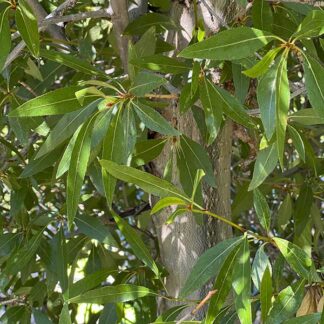
Populus angustifolia / narrow-leaf poplar
- a riparian tree also planted for landscaping
- long, narrow leaves with serrated edges
- furrowed, grey bark on mature trees; smooth and yellow-ish on young trees
- flowers are small, grey catkins in very early spring
- fruits are fluffy white cotton in early-mid summer
-
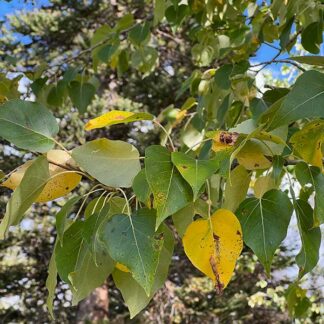
Populus trichocarpa / black cottonwood
- conical tree
- heart or arrow-head shaped leaves; pointy tips
- inflorescences are red or brownish catkins in early spring
- cotton-y fruits disperse in early summer
-

Potamogeton richardsonii / Richardson’s pondweed
- submerged aquatic with emergent inflorescence
- crinkly, broad-ish leaves which clasp the stem
- variable length internodes
- often tangled up with sago pondweed
-
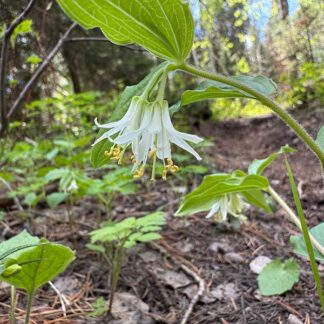
Prosartes trachycarpa / rough-fruited fairybells
- heart-shaped, clasping leaves with parallel veins
- pendant white flowers with 6 petals/tepals, often obscured by leaves
- round, yellow then orange then red fruits with rough surface in late summer
- moist forest understoreys
-

Prunus virginiana / western chokecherry
- oval leaves with serrated margins and abrupt taper at tip
- reddish twigs with prominent lenticels
- drooping clumps of white flowers w/ yellow centers in spring
- red to black cherries in fall, up to ½ inch diameter
- leaves turn orange or yellow in fall
-

Pyrola asarifolia / pink pyrola
- 4 to 25 nodding red (or pink) and white flowers in a loose raceme
- round petals, edges often curved down
- green style extends out of flower like elephant's trunk
- flower stems may be over a foot tall
- leaves are "liver" shaped or "ginger" shaped and shiny - round-ish but wider than long
-

Ranunculus aquatilis / common water crowfoot
- found in slowly flowing water ways, ditches, ponds
- white, waxy flowers with yellow centers; 4 or 5 petals
- flowers raised a couple inches above the water surface
- usually grows in dense mats that look a lot like slime
-
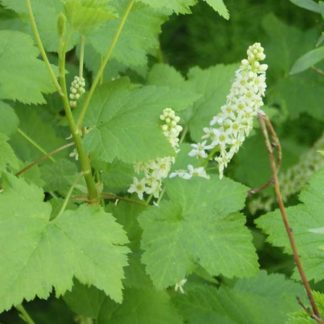
Ribes hudsonianum / northern black currant
- moist wooded areas, streambanks
- erect, spike-like inflorescences with up to 50 white flowers
- bitter berries, ripening to black
- leaves and stems covered with resinous glands
- leaves 3-5 lobed, glandular below
- smells bad
-

Ribes viscosissimum / sticky currant
- shrub to 7 feet tall
- stem and leaves covered with sticky, glandular hairs
- white, bell-like flowers in drooping or erect clusters (up to 15)
- rough leaves, 3-5 equal lobes, toothed margins
- fragrant flowers and leaves
-

Rubus parviflorus / thimbleberry
- raspberry-like shrub usually in a clump
- white flowers with many stamens, up to 2.5 inches diameter
- large, fuzzy maple-like leaves
- blooms in spring; red, raspberry-like fruit in the fall
-
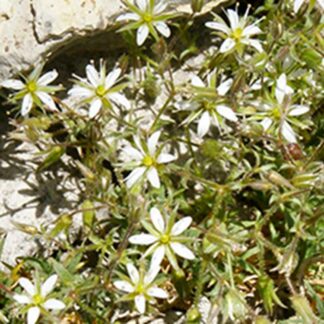
Sabulina nuttallii / Nuttall’s sandwort
- small, glandular-pubescent perennial
- trailing stems form mats
- thin, rigid, needle-like leaves, about ½" long
- small, white, 5-petaled flowers in terminal clusters
- 5 green, pointy sepals
- sagebrush hills to alpine slopes, and especially on gravelly benches or talus
Showing 85–96 of 117 results